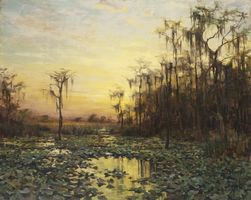ATTENTION: The Cici and Hyatt Brown Museum of Art will be closing at 3:00pm on Saturday, May 3 for a private event.
The innovative Cici and Hyatt Brown Museum of Art is home to the largest collection of Florida art in the world and features a rotating collection of 2,600 Florida-themed oil and watercolor paintings. The Museum's grand central gallery and mezzanine showcase the collection's signature pieces, while six smaller galleries feature beautiful changing exhibitions with Florida themes. A gift shop and a cafe add to the Brown Museum experience and make for the perfect day-long visit to the MOAS campus. Conference rooms with full meeting and presentation capabilities are available to the public on a rental basis.
On May 7, 2012, the Museum of Arts & Sciences, in cooperation with the City of Daytona Beach and the Volusia County Council, announced a $13 million gift for construction of the Cici and Hyatt Brown Museum of Art. This expansion to the Museum of Arts & Sciences will be the permanent home for the Cici and Hyatt Brown collection of more than 2,600 paintings of Florida.
The unprecedented collection, which includes works from the acclaimed Reflections and Reflections II exhibitions, which both made their debuts at the Museum of Arts & Sciences, will be donated over the next several years and is the most extensive collection of Florida art anywhere in the world.
Additional donor dollars will create an endowment for the operation and maintenance of the 26,000 square foot building, which will front Nova Road just north of the existing Museum of Arts & Sciences.

The permanent gallery of the Cici and Hyatt Brown Museum of Art contains the most significant paintings from the Brown's collection of Florida art. Paintings can be found installed on the main floor and the upstairs mezzanine. Artwork with aesthetic and technical qualities signficant in the larger realms of regional and general American arts can be found here. Featured painting: Louis Aston Knight; Sunset on the Suwannee River, ca. 1910